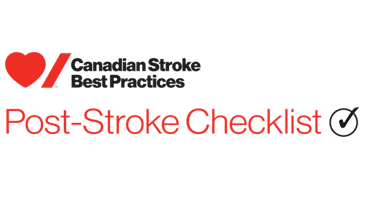- Definition and Considerations
- 1. Supporting People with Stroke, Their Families and Caregivers
- 2. Education for People with Stroke, Their Families and Caregivers
- 3. Interprofessional Care Planning and Communication
- 4. Community Participation Following Stroke
- 5. Transition to Long-Term Care Following a Stroke
- 6. Post Stroke Depression
- 7. Post-Stroke Fatigue
Definitions and Descriptions
Post-Stroke Fatigue: Fatigue following stroke is a multidimensional motor-perceptive, emotional and cognitive experience characterized by a feeling of early exhaustion with weariness, lack of energy and aversion to effort that develops during physical or mental activity and is usually not ameliorated by rest. Fatigue can be classified as either objective or subjective. Objective fatigue is defined as the observable and measurable decrement in performance occurring with the repetition of a physical or mental task, while subjective fatigue is a feeling of early exhaustion, weariness and aversion to effort (Acciarresi et al, 2014; Staub 2001, Annoni 2008, Lerdal 2009, Eskes 2011).
Characteristics of post-stroke fatigue may include: overwhelming tiredness and lack of energy to perform daily activities; abnormal need for naps, rest, or extended sleep; more easily tired by daily activities than pre-stroke; unpredictable feelings of fatigue without apparent reason.
7.0 Post-Stroke Fatigue
Post-stroke fatigue is a common condition and can be experienced following a stroke at any point during the recovery process. Post-stroke fatigue is often under-recognized; thus, healthcare professionals should anticipate the possibility of post-stroke fatigue and prepare people who have experienced a stroke and families to mitigate fatigue through assessment, education, and interventions throughout the stroke-recovery continuum [Evidence Level B].
Note: Post-stroke fatigue does not appear to be correlated to the severity of stroke. People who experience very mild stroke may still experience post-stroke fatigue.
7.1 Screening and Assessment
- Prior to discharge from acute care or inpatient rehabilitation, people who have experienced a stroke, their families and informal caregivers, should be provided with basic information regarding the potential experience of post-stroke fatigue [Evidence Level C].
- Following return to the community, people who have experienced a stroke should be periodically screened for post-stroke fatigue during follow-up healthcare visits (e.g., primary care, home care, and outpatient prevention or rehabilitation clinics) [Evidence Level C]. Refer to Appendix Two Table 3A for a summary of suggested screening tools.
- People who experience post-stroke fatigue should be screened for common and treatable post-stroke co-morbidities and for medications that are associated with and/or exacerbate fatigue [Evidence Level B].
- These may include: signs of depression or other mood-related conditions; sleep disorders or factors that decrease quality of sleep (e.g. sleep apnea, pain); other common post-stroke medical conditions and medications that increase fatigue, e.g. systemic infection such as urinary tract infections, dehydration, sedating drugs, hypothyroidism.
7.2 Management of Post-Stroke Fatigue
- People who have experienced a stroke should be cared for by healthcare professionals who are knowledgeable in the symptoms of fatigue and its management [Evidence Level C].
- There is limited evidence suggesting that pharmacological treatment for post-stroke fatigue with modafinil may be considered in some people who have experienced a stroke [Evidence Level C]. More research is required to fully understand the benefits of this treatment.
- There is currently insufficient evidence to recommend antidepressant treatment for post-stroke fatigue [Evidence Level B].
- Psychotherapy (cognitive behavioural therapy) may be considered as an adjunct treatment for post-stroke fatigue [Evidence Level B].
- Mindfulness based stress reduction may be considered as an adjunct treatment for post-stroke fatigue [Evidence Level B].
- Counselling on graduated exercise schedules with increasing physical demands appropriate to tolerance level to improve deconditioning and physical tolerance is recommended [Evidence Level C].
- Counselling on energy conservation strategies that consider optimizing daily function in high priority activities is recommended (e.g. daily routines and modified tasks that anticipate energy needs and provide a balance of activity/rest) [Evidence Level C]. Refer to Box 3 for detailed examples of energy conservation strategies.
- Counselling on the establishment of good sleep hygiene behaviours is recommended [Evidence Level B]
- Provide education to people who have experienced a stroke, their families and informal caregivers, on daily time management and planning a balance of activities with rest periods [Evidence Level C].
- Encourage people who have experienced a stroke and are experiencing post-stroke fatigue to communicate energy status and rest needs to healthcare providers, family members, caregivers, employers and social groups [Evidence Level C].
Post-stroke fatigue is generally under-diagnosed and not routinely assessed in people who have experienced a stroke. However, symptoms of fatigue are often reported by people who have experienced a stroke in both the acute and chronic stages of recovery following a stroke. Prevalence rates of post-stroke fatigue (PSF) are substantial, varying between 38 and 73%. Additionally, these rates have not shown marked decline after the post-acute stage to even years following the injury. It can occur in any person who has experienced a stroke and has not been found to be dependently related to size, location or severity of stroke. It is commonly associated with low mood and sleep disturbances but can arise in their absence. However, it has been shown to negatively impact a person’s ability to actively participate in rehabilitation, which has been associated with poorer long-term outcomes. Therefore, recommendations are included here to raise awareness of the frequency of post-stroke fatigue, the physical and emotional impact of PSF on people who have experienced a stroke and the negative impact on recovery and outcomes.
- Protocols for the inclusion of post-stroke fatigue in screening and assessments at all transition points and stages of care following a stroke.
- Resources and mechanisms to plan and deliver community-based services which consider the needs of the survivor and family/caregiver and are focused on energy conservation (e.g., access to assistive devices, transportation, and counseling).
- Models of care that include technology such as telemedicine, regular telephone follow-up and web-based support to reduce excess visits to healthcare providers that consume energy.
- Education and increased awareness about post-stroke fatigue and management strategies for people who have experienced a stroke, caregivers, employers and health care professionals.
- The number and proportion of people who have experienced a stroke who report symptoms of post-stroke fatigue, measured at each transition point as a proportion of all people who have experienced a stroke.
- The proportion of people who have experienced a stroke who return to the emergency department or are readmitted to hospital for failure to cope or other fatigue-related reasons.
Measurement Notes
- Standardized and validated measures of post-stroke fatigue have not been published for this population. Many validated scales for fatigue as a condition may be applicable and are reasonable choices at this time.
Health Care Provider Information
Post-Stroke Fatigue Evidence Tables and Reference List
Post-stroke fatigue (PSF) is known to occur commonly, is associated with mood disorders and pain, and negatively impacts recovery. Persons experiencing PSF report common experiences including having less capacity and energy, an abnormal tiredness and an overwhelming need for long-lasting sleep, being easily fatigued, fatigue for which there was no obvious cause or explanation and increased stress sensitivity (Eilertsen et al. 2013).
The incidence of PSF is difficult to estimate given that many patients report symptoms of pre-stroke fatigue (Lerdal et al. 2011). Estimates of incidence/prevalence also vary depending on when fatigue is assessed in the recovery process and which tool is used for assessment. At the time of admission to inpatient rehabilitation, fatigue was present in 51.5% of patients (Schepers et al. (2006) and at the point of discharge, in 58.3% of patients (Van Eijsden et al. 2012). Schepers et al. (2006) reported that fatigue was present in 64.1% and 69.5%, respectively at six months and one year. Overall, fatigue was present in 37.7% of patients and absent in 17.4%, at all assessment points. Of the patients reporting fatigue at one year, 29.3% were also depressed. Van der Port et al. (2007) reported that the percentages of patients considered fatigued at six, 12 and 36 months were 68%, 74% and 58%, respectively, in 223 acute stroke patients followed prospectively. In all these studies, the presence of fatigue was identified based on a score of ≥4 on the Fatigue Severity Scale. Parks et al. (2012) reported that of 228 participants who were surveyed 12 months post stroke, 37% reported symptoms of fatigue at least once during the previous month. Among those reported fatigue, 59.5% stated that fatigue was one of the worst or the worst symptom they experienced. Two years following stroke, of 5,189 patients who were alive and included in the Riks-Stroke national stroke registry, and who responded to a postal survey, 10% and 29.2% of respondents reported “always” or “often” being tired (Glader et al. 2002). In perhaps the largest systematic review of its kind, Cumming et al. (2016) included the results of 49 studies and estimated the prevalence of PSF at any point following stroke. Using the results from 22 studies that used the Fatigue Severity Scale and a cut-off level of ≥4 or >4, the prevalence of post-stroke fatigue was 50%, 95% CI 43–57%.
The clinical course of PSF is unclear; therefore, it’s even unknown if PSF increases or decreases over time. Snaphaan et al. (2011) reported that the prevalence of fatigue was 35% at two months post-stroke and 33% at 18 months. 26% of patients reported fatigue at both assessment points, while 9% reported fatigue at baseline but not at follow-up, and 8% reported no fatigue at baseline but did at follow-up. In a systematic review (Duncan et al. 2012), which included the results of nine studies, the percentage of patients reporting fatigue increased from assessment time one to time two in seven studies, while it had decreased between assessment points in two studies. In contrast, Cumming et al. (2016) reported the estimates of fatigue were relatively stable across time (within three months of stroke 55%, 95% CI 25–85%; one to six months 46%, 95% CI 31–62%; and greater than six months 53%, 95% CI 48–58%). Independent predictors of fatigue that have been identified include depression, low levels of physical functioning, and pre-stroke fatigue (Lerdal et al. 2011). Both increasing (Snaphaan et al. 2011) and decreasing age (Parks et al. 2012), have been reported as predictors of PSF, as have female (Schepers et al. 2006) and male sex (Gladder et al. 2002).
A few controlled studies have been conducted comparing fatigue in persons recovering from stroke with persons from the general population and in cases of transient ischemic attack. When compared with 1,069 persons of similar ages selected from the general population, the fatigue scores of 165 patients with acute stroke were significantly higher after adjusting for age, sex and living arrangements. Of the five subscale components of the Multidimensional Fatigue Inventory (MFI-20), stroke patients had significantly higher general and physical fatigue scores and also higher reduced activity scores at three months (Christensen et al. 2008). Winward et al. (2009) compared 73 subjects with minor stroke and 76 subjects with transient ischemic attack who were participants in the Oxford Vascular study. At six months, a higher proportion of participants with stroke reported significant fatigue, assessed using the Chalder Fatigue Scale (56% vs. 29%, p=0.008). A higher proportion of subjects with stroke, who had initial NIHSS scores of 0 reported significant fatigue compared with transient ischemic attack with initial NIHSS scores of 0 (57% vs. 29%, p=0.015). Subjects who felt they had not made a full recovery were more likely to be fatigued compared to those who felt they had (72% vs. 23%, p<0.0001).
There are few treatments for post-stroke fatigue that have been evaluated. A Cochrane review (Wu et al. 2015) included the results from 12 RCTs, four evaluating four pharmacological and four evaluating non-pharmacological approaches. In the remaining four trials, PSF was not the primary target of investigation, but fatigue was reported as an outcome. Using the results from seven trials (five pharmacological, two no-pharmacological), treatment was associated with a significant reduction in fatigue scores (WMD= -1.07, 95% CI -1.93, -0.21, p=0.014).
Pharmacological agents that have been evaluated in the treatment of PSF include selective serotonin reuptake inhibitors (fluoxetine) and modafinil. In the Modafinil in Debilitating Fatigue After Stroke (MIDAS) trial, 36 participants with PSF received 200 mg modafinil or placebo for six weeks (Bivard et al. 2017). Active treatment was associated with a significantly greater decrease in mean total Multidimensional Fatigue Inventory (MFI)-20 scores (MD= −7.38, 95% CI −21.76 to −2.99; P<0.001), mean FSS scores (MD= -6.31, 95% CI -10.7 to -1.9, p=0.048) and a significantly greater increase in total mean Stroke-Specific Quality of Life scores (MD=11.8, 95% CI 2.3 to 21.3, p=0.015). Poulsen et al. (2015) randomized 41 persons with PSF to receive 400 mg modafinil for 90 days. The results were ambiguous. At 90 days, there was no significant difference between groups in the median MFI-20 GF score (11 modafinil vs placebo 14, p=0.32), or in the median score of other MFI domains (physical fatigue, reduced activity, reduced motivation); however, median FSS and FSS-7 were significantly lower at 90 days for patients in the modafinil group (36 vs. 49.5, p=0.02 and 22 vs. 37.5, p=0.042). Fluoxetine was examined in a trial including 83 participants with post-stroke emotional disturbances, an average of 14 months after stroke onset, were randomized to receive 20 mg/day of fluoxetine (n=40) or placebo, (n=43) for three months (Choi-Kwon et al. 2007). At the end of treatment, there were no significant differences in the number of patients with PSF. At six months, 34 patients (85%) in the fluoxetine group reported PSF compared with 40 (93%) in the control group. However, at three months, fewer patients in the fluoxetine group reported excessive/inappropriate crying (n=16, 40% vs. n=27, 62.8%, p=0.038), and at six months fewer patients in the fluoxetine group were identified with depression (n=5, 12.5% vs. n=13, 30.2%, p=0.05).
Among trials evaluating non-pharmacological treatments for PSF, two reported significant improvements in symptoms. Zedlitz et al. (2013) randomized 83 participants with severe fatigue >4 months post stroke to participate in a 12-week program consisting of group cognitive treatment (control condition) or group cognitive treatment combined with graded activity training (COGRAT). Cognitive treatment consisted of cognitive behavioural therapy and compensatory strategy teaching. Those in the COGRAT group also received 24 sessions, each two hours in duration of graded activity training, including treadmill walking, strength training, and homework assignments. Participants who received COGRAT were significantly more likely to experience clinically relevant improvement in fatigue severity (57.9% vs. 24.4%, p=0.002). Johansson et al. (2012) randomized 29 patients, of whom 18 were recovering from stroke (11 from traumatic brain injury) with mental fatigue to participate in an eight-week program of Mindfulness–Based Stress Reduction (MBSR), which included yoga, body scan, and sitting meditation, or to a wait list control group. Compared with those in the wait list control group, participants who received the MBSR program immediately reported a significantly greater decrease in Mental Fatigue Scale scores. Non-pharmacological interventions that have been evaluated for the treatment of PSF and found not to be effective include the use of continuous positive airway pressure (Brown et al. 2011), a fatigue management education program (Clarke et al. 2012) and a six-month chronic disease self-management program (Lorig et al. 2001).





